NCERT Exemplar: Digestion and Absorption (Old NCERT) | Biology for Grade 11 PDF Download
| Table of contents |

|
| Multiple Choice Questions |

|
| Very Short Answer Type Questions |

|
| Short Answer Type Questions |

|
| Long Answer Type Questions |

|
Multiple Choice Questions
Q.1. Which of the following is not true of intestinal villi?
(a) They possess microvilli
(b) They increase the surface area
(c) They are supplied with capillaries and the lacteal vessels
(d) They only participate in digestion of fats
Ans. (d)
Sol. They only participate in digestion of fats.
- Intestinal villi are the numerous small finger-shaped projections which increase the absorptive surface area, they contain abundant blood capillaries and lymph vessels, they do not participate in the digestion of fats but helps in absorption of fats and other food substances.
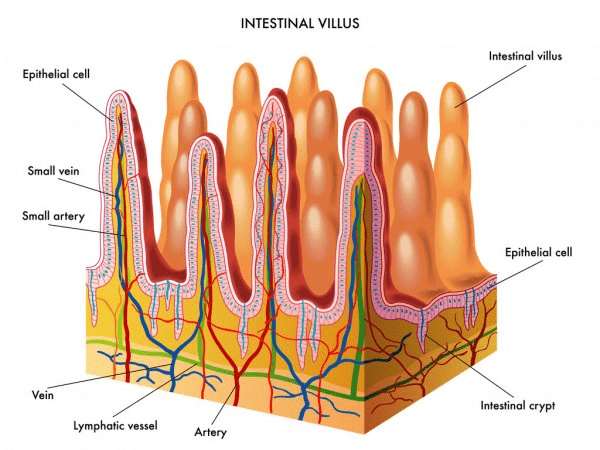 Structure of Intestinal VilliQ.2. Hepato-pancreatic duct opens into the duodenum and carries
Structure of Intestinal VilliQ.2. Hepato-pancreatic duct opens into the duodenum and carries
(a) Bile
(b) Pancreatic juice
(c) Both bile and pancreatic juice
(d) Saliva
Ans. (c)
Sol. Hepato-pancreatic duct opens into the duodenum and carries both bile and pancreatic juice.
Q.3. Which of the following is not a common disorder associated with digestive system?
(a) Tetanus
(b) Diarrhoea
(c) Jaundice
(d) Dysentery
Ans. (a)
Sol. Tetanus is not a common disorder associated with digestive system.
- Tetanus also called lockjaw disease is a serious bacterial infection that causes painful muscle spasms and can even lead to death, while diarrhoea, jaundice, dysentery are disorders related to the digestive system.
Q.4. A gland not associated with the alimentary canal is:
(a) Pancreas
(b) Adrenal
(c) Liver
(d) Salivary glands
Ans. (b)
Sol. A gland not associated with the alimentary canal is adrenal (this is endocrine gland).
- Human alimentary canal or gastrointestinal tract associates wit salivary glands, liver, pancreas, small intestine etc.
- The adrenal glands are endocrine glands that produce a wide variety of hormones.
- They are found above the kidneys and consist of a number of different layers that directly influence the structure and function of the glands. It is not associated with alimentary canal.
Q.5. Match the two columns and select the correct among options given:

Options:
(a) A-ii, B-i, C-v, D-iii, E-iv
(b) A-iv, B-i, C-v, D-ii, E-iii
(c) A-i, B-ii, C-iii, D-iv, E-v
(d) A-i, B-iii, C-ii, D-iv, E-v
Ans. (b)
Sol.

Q.6. Match the two columns and select the right one among options given:

Options:
(a) A-i, B-ii, C-iii, D-iv
(b) A-iv, B-iii, C-ii, D-i
(c) A-iii, B-i, C-iv, D-ii
(d) A-ii, B-iv, C-i, D-iii
Ans. (c)
Sol.

Q.7. Match the enzyme with their respective substrate and choose the right one among options given:

Options:
(a) A-ii, B-iii, C-i, D-iv
(b) A-iii, B-iv, C-ii, D-i
(c) A-iii, B-i, C-iv, D-ii
(d) A-ii, B-iii, C-iv, D-i
Ans. (d)
Sol.

Q.8. Dental formula in human beings is:
(a) 3223/3223
(b) 2123/2123
(c) 1232/1232
(d) 2233/2233
Ans. (b)
Sol. Dental formula in human beings is 2123/2123.
Q.9. Liver is the largest gland and is associated with various functions. Choose which is not correct from the following.
(a) Metabolism of carbohydrate
(b) Digestion of fat
(c) Formation of bile
(d) Secretion of hormone called gastrin
Ans. (d)
Sol. Liver is the largest gland and is associated with functions metabolism of carbohydrate, digestion of fat and formation of bile.
Q.10. Mark the right statement among the following
(a) Trypsinogen is an inactive enzyme.
(b) Trypsinogen is secreted by intestinal mucosa.
(c) Enterokinase is secreted by pancreas.
(d) Bile contains trypsin.
Ans. (a)
Sol. 
Very Short Answer Type Questions
Q.1. The food mixes thoroughly with the acidic gastric juice of the stomach by the churning movements of its muscular wall. What do we call the food then?
Ans. Chyme
Q.2. Trypsinogen is an inactive enzyme of pancreatic juice. An enzyme, enterokinase, activates it. Which tissue/ cells secrete this enzyme?/ How is it activated?
Ans. Intestinal mucosa
Q.3. In which part of alimentary canal does absorption of water, simple sugars and alcohol takes place?
Ans. Stomach
Q.4. Name the enzymes involved in the breakdown of nucleotides into sugars and bases?
Ans. Nucleotidases and Nucleosidases
Q.5. Define digestion in one sentence.
Ans. The process of conversion of complex food substances in the digestive system to simple absorbable forms is called digestion.
Q.6. What do we call the type of teeth attachment to jaw bones in which each tooth is embedded in a socket of jaws bones?
Ans. Thecodont
Q.7. Stomach is located in upper left portion of the abdominal cavity and has three major parts. Name these three parts.
Ans. Cardiac, fundic and pyloric.
Q.8. Does gall bladder make bile?
Ans. No, it only stores.
Q.9. Correct the following statements by deleting one of entries (underlined).
(a) Goblet cells are located in the intestinal mucosal epithelium and secrete chymotrypsin / mucus.
(b) Fats are broken down into di- and monoglycerides with the help of amylase / lipases.
(c) Gastric glands of stomach mucosa have oxyntic cell / chief cells which secrete HCl.
(d) Saliva contains enzymes that digest starch / protein.
Ans.
(a) Goblet cells are located in the intestinal mucosal epithelium and secrete mucus.
(b) Fats are broken down into di- and monoglycerides with the help of lipases.
(c) Gastric glands of stomach mucosa have oxyntic cell which secrete HCl.
(d) Saliva contains enzymes that digest starch.
Short Answer Type Questions
Q.1. What is pancreas? Mention the major secretions of pancreas that are helpful in digestion.
Ans. Pancreas is a gland having exocrine and endocrine portions involved in secreting digestive enzymes as well as hormones. Major secretions of pancreas involved in digestion are inactive enzymes listed below:
(a) Trypsinogen
(b) Chymotrypsinogen
(c) Procarboxypeptidases
(d) Amylases
(e) Lipases
(f) Nucleases
Q.2. Name the part of the alimentary canal where major absorption of digested food takes place. What are the absorbed forms of different kinds of food materials?
Ans. Small intestine is the part of alimentary canal where digested food materials are mainly absorbed. Amino acids (proteins), monosaccharides like glucose, fructose, galactose, etc. (carbohydrate) and fatty acids and glycerol (fats) are different absorbable forms of food materials.
Q.3. List the organs of human alimentary canal and name the major digestive glands with their location.
Ans.
- The alimentary canal begins with an anterior opening the mouth and then buccal cavity, pharynx, oesophagus, stomach, small intestine, large intestine and it opens out posteriorly through the anus.
- The digestive glands associated with the alimentary canal include the salivary glands, the liver and the pancreas. Saliva is mainly produced by three pairs of salivary glands, the parotids (cheek), the sub-maxillary/sub-mandibular (lower jaw) and the sublinguals (below the tongue).
- Liver is situated in the abdominal cavity, just below the diaphragm. The pancreas is situated between the limbs of the ‘C’-shaped duodenum.
Q.4. What is the role of gall bladder? What may happen if it stops functioning or is removed?
Ans. The bile secreted by the hepatic cells passes through the hepatic ducts and is stored and concentrated in a thin muscular sac called the gall bladder. Bile helps in emulsification of fats, i.e., breaking down of the fats into very small micelles. Bile also activates lipases. If it stops functioning or is removed then digestion of fat will be affected.
Q.5. Correct the statement given below by the right option shown in the bracket against them
(a) Absorption of amino acids and glycerol takes place in the (small intestine / large intestine).
(b) The faeces in the rectum initiate a reflex causing an urge for its removal (neural / hormonal).
(c) Skin and eyes turn yellow in infection (liver / stomach).
(d) Rennin is a proteolytic enzyme found in gastric juice in (infants / adults).
(e) Pancreatic juice and bile are released through. (intestine pancreatic / hepato- pancreatic duct)
(f) Dipeptides, disaccharides and glycerides are broken down into simple substances in region of small intestine (jejunum / duodenum).
Ans.
(a) Absorption of amino acids and glycerol takes place in the small intestine.
(b) The faeces in the rectum initiate a neural reflex causing an urge for its removal.
(c) Skin and eyes turn yellow in infection of liver.
(d) Rennin is a proteolytic enzyme found in gastric juice in infants.
(e) Pancreatic juice and bile are released through hepato-pancreatic duct.
(f) Dipeptides, disaccharides and glycerides are broken down into simple substances in duodenum region of small intestine.
Q.6. What are three major types of cells found in the gastric glands? Name their secretions.
Ans. The mucosa of stomach has gastric glands.
Gastric glands have three major types of cells namely:
(i) Mucus neck cells which secrete mucus.
(ii) Peptic or chief cells which secrete the proenzyme pepsinogen.
(iii) Parietal or oxyntic cells which secrete HCl and intrinsic factor (factor essential for absorption of vitamin B12).
Q.7. How is the intestinal mucosa protected from the acidic food entering from stomach?
Ans. The mucus and bicarbonates present in the gastric juice play an important role in lubrication and protection of the mucosal epithelium from excoriation by the highly concentrated hydrochloric acid.
Q.8. How are the activities of gastro-intestinal tract regulated?
Ans.
- The activities of the gastro-intestinal tract are under neural and hormonal control for proper coordination of different parts.
- The sight, smell and/or the presence of food in the oral cavity can stimulate the secretion of saliva. Gastric and intestinal secretions are also, similarly, stimulated by neural signals.
- The muscular activities of different parts of the alimentary canal can also be moderated by neural mechanisms, both local and through CNS.
- Hormonal control of the secretion of digestive juices is carried out by local hormones produced by the gastric and intestinal mucosa.
Q.9. Distinguish between constipation and indigestion. Mention their major causes.
Ans.
- Constipation: In constipation, the faeces are retained within the rectum as the bowel movements occur irregularly.
- Indigestion: In this condition, the food is not properly digested leading to a feeling of fullness. The causes of indigestion are inadequate enzyme secretion, anxiety, food poisoning, overeating, and spicy food.
Q.10. Describe the enzymatic action on fats in the duodenum.
Ans.
- In the duodenum, fats are broken down by pancreatic lipases with the help of bile into di- and monoglycerides.

- Intestinal lipases act on di- and monoglycerides and converts into fatty acids and glycerol.

Long Answer Type Questions
Q.1. A person had roti and dal for his lunch. Trace the changes in those during its passage through the alimentary canal.
Ans.
- The process of digestion is accomplished by mechanical and chemical processes. The buccal cavity performs two major functions, mastication of food and facilitation of swallowing.
- The teeth and the tongue with the help of saliva masticate and mix up the food thoroughly. Mucus in saliva helps in lubricating and adhering the masticated food particles into a bolus.
- The bolus is then conveyed into the pharynx and then into the oesophagus by swallowing or deglutition. The bolus further passes down through the oesophagus by successive waves of muscular contractions called peristalsis.
- The gastro-oesophageal sphincter controls the passage of food into the stomach. The saliva secreted into the oral cavity contains electrolytes and enzymes, salivary amylase and lysozyme.
- The chemical process of digestion is initiated in the oral cavity by the hydrolytic action of the carbohydrate splitting enzyme, the salivary amylase. About 30% of starch is hydrolysed here by this enzyme (optimum pH 6.8) into a disaccharide – maltose.
- The stomach stores the food for 4-5 hours. The food mixes thoroughly with the acidic gastric juice of the stomach by the churning movements of its muscular wall and is called the chyme. The proenzyme pepsinogen, on exposure to hydrochloric acid gets converted into the active enzyme pepsin, the proteolytic enzyme of the stomach. Pepsin converts proteins into proteoses and peptones (peptides).
- The bile, pancreatic juice and the intestinal juice are the secretions released into the small intestine. Pancreatic juice and bile are released through the hepato-pancreatic duct. The pancreatic juice contains inactive enzymes—trypsinogen, chymotrypsinogen, procarboxypeptidases, amylases, lipases and nucleases. Trypsinogen is activated by an enzyme, enterokinase, secreted by the intestinal mucosa into active trypsin, which in turn activates the other enzymes in the pancreatic juice.
- Proteins proteoses and peptones (partially hydrolysed proteins) in the chyme reaching the intestine are acted upon by the proteolytic enzymes of pancreatic juice as given below.

- Carbohydrates in the chyme are hydrolysed by pancreatic amylase into disaccharides.

- Fats are broken down by lipases with the help of bile into di- and monoglycerides.

- Nucleases in the pancreatic juice acts on nucleic acid to form nucleotides and nucleosides.

- The enzymes in the succus entericus act on the end product of the above reactions to form the respective simple absorbable forms.
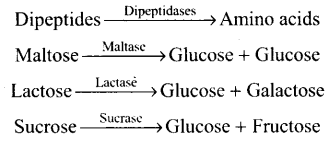


Q.2. What are the various enzymatic types of glandular secretions in our gut helping digestion of food? What is the nature of end products obtained after complete digestion of food?
Ans. Enzymatic types of glandular secretions in our gut are:
(a) Salivary glands
- Saliva is mainly produced by three pairs of salivary glands, the parotids (cheek), the sub-maxillary/sub-mandibular (lower jaw) and the sublingual (below the tongue).
- These glands situated just outside the buccal cavity secrete salivary juice into the buccal cavity.
(b) Gastric glands
The mucosa of stomach has gastric glands.
Gastric glands have three major types of cells namely:
- mucus neck cells which secrete mucus
- peptic or chief cells which secrete the proenzyme pepsinogen
- parietal or oxyntic cells which secrete HC1 and intrinsic factor (factor essential for absorption of vitamin B12).
(c) The Bile, Pancreatic and the Intestinal juice
- The bile, pancreatic juice and the intestinal juice are the secretions released into the small intestine. Pancreatic juice and bile are released through the hepato-pancreatic duct.
- The pancreatic juice contains inactive enzymes—trypsinogen, chymotrypsinogen, procarboxypeptidases, amylases, lipases and nucleases.
- Trypsinogen is activated by an enzyme, enterokinase, secreted by the intestinal mucosa into active trypsin, which in turn activates the other enzymes in the pancreatic juice.
- The bile released into the duodenum contains bile pigments (bilirubin and biliverdin), bile salts, cholesterol and phospholipids but no enzymes.
The nature of end products obtained after digestion of food:
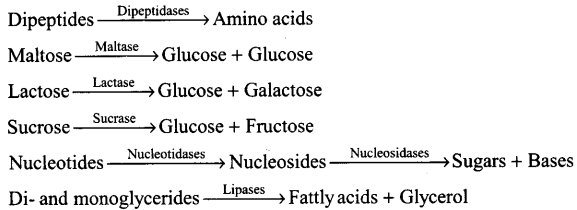
Q.3. Discuss mechanisms of absorption.
Ans.
- Absorption is the process by which the end products of digestion pass through the intestinal mucosa into the blood or lymph. It is carried out by passive, active or facilitated transport mechanisms.
- Small amounts of monosaccharides like glucose, amino acids and some electrolytes like chloride ions are generally absorbed by simple diffusion. The passage of these substances into the blood depends upon the concentration gradients.
- However, some substances like glucose and amino acids are absorbed with the help of carrier proteins. This mechanism is called the facilitated transport.
- Transport of water depends upon the osmotic gradient. Active transport occurs against the concentration gradient and hence requires energy.
- Various nutrients like amino acids, monosaccharides like glucose, electrolytes like Na+ are absorbed into the blood by this mechanism.
Q.4. Discuss the role of hepato – pancreatic complex in digestion of carbohydrate, protein and fat components of food.
Ans.
- The bile, pancreatic juice and the intestinal juice are the secretions released into the small intestine. Pancreatic juice and bile are released through the hepato-pancreatic duct.
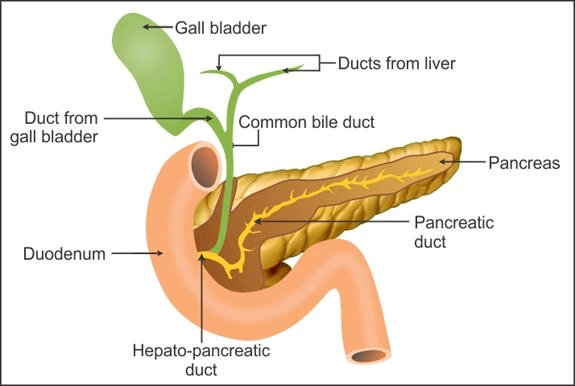 The duct system of Liver, Gall bladder and Pancreas
The duct system of Liver, Gall bladder and Pancreas - The pancreatic juice contains inactive enzymes— trypsinogen, chymotrypsinogen, procarboxypeptidases, amylases, lipases and nucleases. Trypsinogen is activated by an enzyme, enterokinase, secreted by the intestinal mucosa into active trypsin, which in turn activates the other enzymes in the pancreatic juice.
- The bile released into the duodenum contains bile pigments (bilirubin and biliverdin), bile salts, cholesterol and phospholipids but no enzymes. Bile helps in emulsification of fats, i.e., breaking down of the fats into very small micelles. Bile also activates lipases.
- Proteins proteases and peptones (partially hydrolysed proteins) in the chime reaching the intestine are acted upon by the proteolytic enzymes of pancreatic juice as given below:

- Carbohydrates in the chyme are hydrolysed by pancreatic amylase into disaccharides.

- Fats are broken down by lipases with the help of bile into di- and monoglycerides.

- Nucleases in the pancreatic juice acts on nucleic acid to form nucleotides and nucleosides.

Q.5. Explain the process of digestion in the buccal cavity with a note on the arrangement of teeth.
Ans.
Arrangement of Teeth
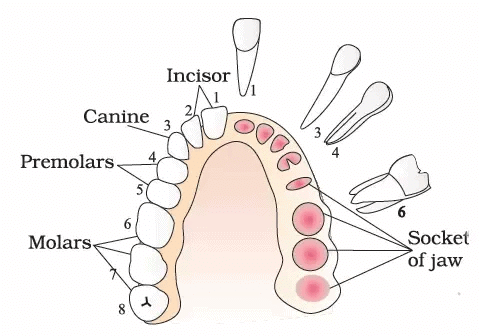 Arrangement of Teeth on one side and the sockets on the other side
Arrangement of Teeth on one side and the sockets on the other side
Process of digestion in Buccal cavity
- The buccal cavity performs two major functions, mastication of food and facilitation of swallowing. The teeth and the tongue with the help of saliva masticate and mix up the food thoroughly.
- Mucus in saliva helps in lubricating and adhering the masticated food particles into a bolus. The bolus is then conveyed into the pharynx and then into the oesophagus by swallowing or deglutition.
- The bolus further passes down through the oesophagus by successive waves of muscular contractions called peristalsis. The gastro-oesophageal sphincter controls the passage of food into the stomach.
- The saliva secreted into the oral cavity contains electrolytes and enzymes, salivary amylase and lysozyme. The chemical process of digestion is initiated in the oral cavity by the hydrolytic action of the carbohydrate splitting enzyme, the salivary amylase.
- About 30% of starch is hydrolysed here by this enzyme (optimum pH 6.8) into a disaccharide—maltose. Lysozyme present in saliva acts as an antibacterial agent that prevents infections.
|
219 videos|306 docs|270 tests
|
FAQs on NCERT Exemplar: Digestion and Absorption (Old NCERT) - Biology for Grade 11
| 1. What is digestion and absorption? |  |
| 2. How does digestion occur in the human body? |  |
| 3. What are the different stages of digestion? |  |
| 4. How does the digestive system work? |  |
| 5. What are the common digestive disorders? |  |
















